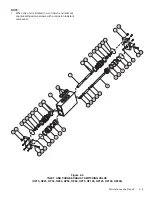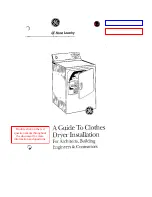
3 - 4
Operation
Dryer Models OP400 and OP500
1.
Close any manual vent or drain valves installed in
prefilter and afterfilter assemblies.
2.
If the prefilter assembly utilized was factory-equipped
with an automatic drain valve or drain trap, inspect
for, and remove pipe plug or cap which may have
been installed in drain port for shipping purposes.
3.
Ensure that all associated pipe and tubing connec-
tions, flanges, unions, plugs, mounting bolts, pipe
hangers, etc., have been checked tight and/or prop-
erly secured.
IMPORTANT: It is recommended that the System's
process gas output not be consumed or used at the
intended points of use until the Start-Up and any re-
lated adjustments have been completed, and the sys-
tem is producing process gas of the required quality.
The quality of the process gas should be verified
through test and analysis when a specific quality pro-
cess gas is required.
4.
Refer to the applicable drawings which accompany
this manual as necessary for component identification
and location while conducting start-up and operational
procedures.
Note: If your dryer cannot be started, or fails to start
due to special installation or other problems, contact
your local General Pneumatics Sales Representative
for assistance.
5.
Close the customer-supplied System Inlet Isolation
Valve.
6.
Open customer-supplied System Bypass Valve, if in-
stalled.
7.
Close customer-supplied System Outlet Isolation
Valve.
8.
Supply compressed air up to Inlet Isolation Valve.
9.
Close the Pilot Gas Supply Valve and pressurize the
pilot gas system with compressed gas to line pres-
sure. Use the Ball Valve located in the pilot gas line
prior to the Pilot Gas Filter and after the Pilot Gas
Supply Valve. Both desiccant chamber Inlet Valves
will open and both Purge Exhaust Valves will close.
10. Supply pressure to system by slowly opening the Sys-
tem Inlet Isolation Valve (customer supplied). Both
Inlet Switching Valves are open. Both Purge Exhaust
Switching Valves are closed (Refer to step 9). The
desiccant chambers will immediately begin pressuriz-
ing to system pressure as indicated by chamber pres-
sure gauges.
11. When both chambers are at supply pressure, open
the Pilot Gas Supply Valve and disconnect the gas
supply to the pilot gas system at the Start-Up Ball
Valve.
12. The Moisture Indicator’s (if dryer so-equipped) bleed
valve is installed directly into the back of the
indicator’s body. Close the Indicator’s Bleed Valve.
FULLY open the Moisture Indicator Supply Valve.
13. Soap bubble test all external piping, fittings, and con-
nections. Locate and repair all noted points of leak-
age. Do not soap bubble test components lo-
cated inside dryer control system's enclosure.
Note: Small leaks noted in inlet piping to the dryer
will not affect operation, other than a slight loss of
pressure supplied to the dryer. HOWEVER, any gas
leaks, (no matter how small), detected at, or down-
stream of the dryer outlet MUST BE FIXED to ensure
that the dryer will provide a continuous supply of pro-
cess gas at specified dew point, to intended points-of-
use.
IMPORTANT: Water molecules can diffuse through
a pinhole-size leak even though pressure inside the
piping is several hundred PSIG. It is not uncommon
to have a minute pinhole leak in a gas line cause an
increase in dew point from -40°F to -10°F at a dis-
tance of forty or more feet downstream of the leak.
14. SLOWLY open the System Outlet Isolation Valve
(customer supplied), while monitoring the Outlet Pres-
sure Gauge (if dryer so-equipped). DO NOT permit
the Dryer's Outlet Pressure Gauge to exceed a 5%
drop in pressure while pressurizing downstream pip-
ing.
15. Close the System Bypass Valve (if gas system has
been so-equipped).
16. Open and adjust the Moisture Indicator’s Bleed Valve
until a very slight, continuous gas bleed is felt ex-
hausting from the bleed valve’s exhaust port. Ensure
that the granular indicator crystals remain motionless
after final adjustment.
17. Energize the dryer’s electrical power supply.
18. PURGE SETTING AND ADJUSTMENT
a) Locate the appropriate Critical Orifice Calibration
Curve in Appendix D of this manual.
b) To calculate purge flow consumption on the criti-
cal orifice curve:
Inlet Flow (SCFM) × 14.7 PSIG
× 1.15 = Purge (SCFM)
Inlet Pressure (PSIG) + 14.7 PSIG
Cross the Purge Flow requirement calculated
above to the same number on the Critical Orifice
Calibration Curve. Follow this line vertically and
then horizontally once intersection is made with
the curve line to find the actual purge pressure
setting.
















































